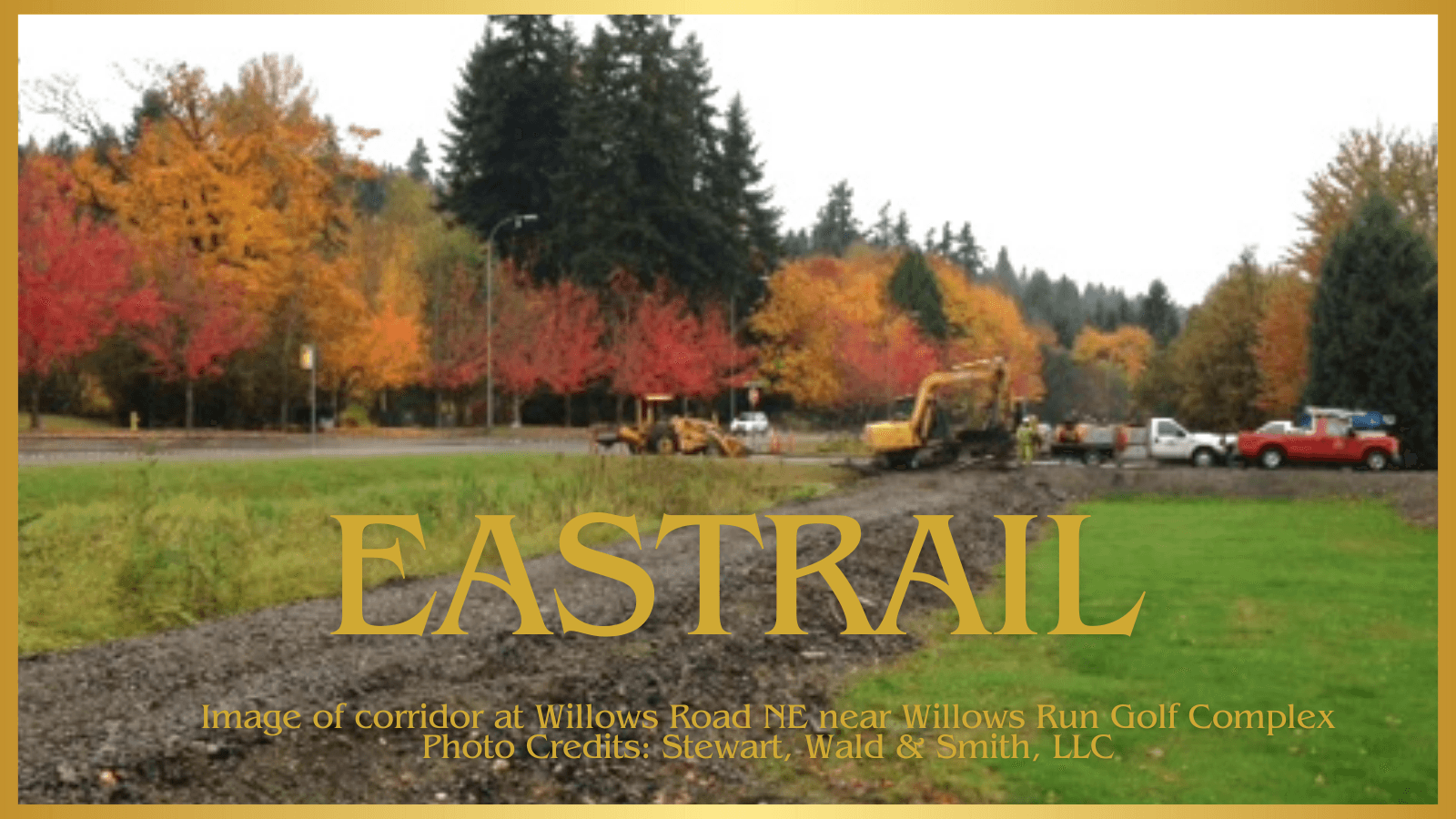The Story of the Eastrail
The Story of the Eastrail

The Eastrail is a collaborative project between King County, Sound Transit, City of Kirkland, City of Woodinville, Snohomish County, and Puget Sound Energy. Each of these entities own different segments of the trail.
The Eastrail runs 42 miles along the east side of Lake Washington – from Renton to Snohomish, Washington.
But one must not forget, it all started with a railroad.
History of the Railroad
The Eastrail in Washington has a rich history that dates to the early 1900’s. Originally a railroad corridor, the trail has undergone a remarkable transformation over the decades. Before it was the Eastrail, the corridor was the lifeblood of Washington’s transportation system through the 19th and early 20th centuries.
The railroad that once occupied the corridor was originally the Chicago, Milwaukee, St. Paul and Pacific Railroad, which was completed in 1909. The railroad was primarily used to transport coal, lumber, and other resources through the area and across the state. The railroad played a pivotal role in the region’s growth, facilitating trade and economic development during the 1900’s. Although Chicago, Milwaukee, St. Paul and Pacific Railroad originally established the railroad corridors and routes in the area, they experienced financial difficulty through the 1970’s and 1980’s and sold portions of its line to Burlington Northern Santa Fe (“BNSF”)[3]. As the years went by, the use of the railroad greatly declined, giving way to the use of trucks, buses, and automobiles. BNSF eventually abandoned the railroad corridors that now make up the Eastrail section after section, making way for a network of nature and hiking trails.
Converting the Railway to a Trailway
The entire 42 miles of the Eastrail was not abandoned and converted into a rail-trail immediately, but in segments, and it was not an overnight success. The project to re-purpose the railroad corridor began in the 1990’s when a group of citizens formed the Eastside Rail Corridor Coalition. The coalition advocated for the preservation of the corridor and for it to be turned into a trail to benefit the community. Today, the Eastside Rail Corridor Regional Advisory Council leads the project.[1] This project took decades of work and negotiation with government agencies to see the project come to life.
For example, the Centennial Trail South portion of the Eastrail, which will extend from the current Centennial Trail in the City of Snohomish south to Woodinville, was acquired in March 2016. At that time, Snohomish County Council approved a purchase and sale agreement to acquire the railroad right-of-way for the extension of the trail. Now, almost eight years later, the trail is well on its way to construction, as the County is actively designing the trail and seeking federal approval to convert the right-of-way into a trail. Once complete, this 12-mile segment will be the final connection through Snohomish County, from the Skagit County line to the King County line.
Who determines if the railway can be converted to a trail?
One of the many government agencies that played a role in this transformation was a federal agency called the United States Surface Transportation Board (“STB”). The STB is an independent federal agency that oversees railroad corridors under federal jurisdiction across the country and has the authority to authorize or deny the conversion of a railroad right-of-way to a recreational trail. This process is known as “railbanking” and effectively converts the railroad right-of-way to a recreational space permanently, or until a railroad company wishes to re-establish rail service along the corridor. As BNSF made the decision to abandon the railroad corridor segments, they were required to file those abandonment documents with the STB. Following those filings, the STB was then able to authorize trail use along each segment of the corridor.
This process is governed by the Trails Act, enacted by Congress in 1983, which seeks to preserve these corridors of land that railroad companies used.
To learn more about the Trails Act, check out our Landowners’ Guide to the Trails Act.
Background of the Trails Act and Railbanking along the Eastrail
In the early 2000’s, BNSF re-routed its transportation into the Boeing plant in Renton, making the Woodinville Subdivision and Redmond Spur a dormant line. These 42 miles of dormant railroad corridor became the topic of a study in 2007 when the trails group leaders determined it could be used for trail use. The Puget Sound Regional Council recommended the segment for railbanking. Following Puget Sound Regional Councils lead, Port of Seattle and King County petitioned the STB to railbank additional segments along Lake Washington.[2]
What if I own property adjacent to the railway?
If your property is directly adjacent to the Eastrail extension, you may have a Trails Act claim. Many times, landowners with claims are unaware of their ability to obtain money damages for the taking of their property which is within the railway. You may have assumed that the railroad owns the land in the corridor; however, under the “centerline presumption,” the landowner is presumed to own the land within the corridor which directly abuts their property.
Based upon this presumption, if an organization acquires the railroad corridor, and the corridor is converted to a recreational trail, then the government owes you money damages for the taking of your land.
To be compensated, you as the landowner need to file a takings claim against the federal government. These cases are unique because they are considered “inverse condemnation,” and the landowner must affirmatively bring a claim against the government for money damages.
When filing these claims, it’s important to retain legal counsel that is skilled and experienced in this exact area of law. Our firm, Stewart, Wald & Smith, is the only law firm in the country that is fully dedicated to rails-to-trails litigation – it is literally all we do – and we have extensive experience with these claims. We have worked hard to recover more than $390 Million for landowners in Rails-to-Trails litigation.
If you own land along this railroad corridor and have questions about your right to a claim or the future of this trail, contact our firm. Our attorneys will help you understand the process for this conversion, your rights, and will help you determine the best way to proceed with your claim.
Does my claim affect the trail being constructed?
No, filing a Trails Act claim will not delay the construction of this trail nor is it adverse to the creation of the trail. These claims are neutral towards the trail, its creators, and its operators. You are simply filing a case against the federal government asking them to pay you fair money damages for the taking of your land used to create this trail.
We are here to help you obtain the money damages the government owes for your property. If you have questions or want to learn more about our firm, then please contact us at 816-303-1500.
[1] https://kingcounty.gov/en/legacy/council/issues/erc.aspx
[2] https://dcms-external.s3.amazonaws.com/DCMS_External_PROD/1680538955151/306404.pdf
[3] https://en.wikipedia.org/wiki/Milwaukee_Road
View on LinkedIn

Did you receive our mailer, or have any questions for us? We’re here to help you take the next step for just compensation.
Notable Success Examples
-
In Haggart v. United States, our attorneys recovered $177,400,000 on behalf of 254 landowners in King County, Washington, along a 25.45-mile trail.
-
In Raulerson v. United States, our attorneys recovered $33,300,000 on behalf of 264 landowners in Beaufort County, South Carolina, along a 25.05-mile trail.
-
In Smith v. United States, our attorneys recovered $26,477,000 on behalf of 29 landowners in King County, Washington, along a 25.45-mile trail.
-
In Ansley Walk v. United States, our attorneys recovered $18,416,000 on behalf of 5 landowners in Fulton County, Georgia, along a 1-mile trail.
-
In Furlong v. United States, our attorneys recovered $14,200,000 on behalf of 272 landowners in Albany, New York, along a 10.94-mile trail.
